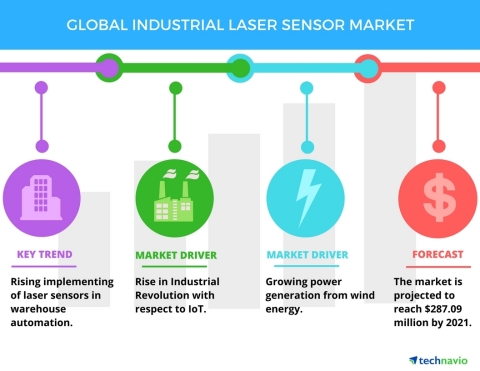LONDON--(BUSINESS WIRE)--Technavio market research analysts forecast the global industrial laser sensor market to grow at a CAGR of more than 10% during the forecast period, according to their latest report.
The market study covers the present scenario and growth prospects of the global industrial laser sensor market for 2017-2021. The report also lists discrete industry and process industry as the two major end-user segments, of which the discrete industry accounted for more than 65% of the market share in 2016.
This report is available at a USD 1,000 discount for a limited time only: View market snapshot before purchasing
Buy 1 Technavio report and get the second for 50% off. Buy 2 Technavio reports and get the third for free.
Technavio analysts highlight the following three market drivers that are contributing to the growth of the global industrial laser sensor market:
- Rise in Industrial Revolution with respect to IoT
- Increasing use of CMOS displacement sensors
- Growing power generation from wind energy
Looking for more information on this market? Request a free sample report
Technavio’s sample reports are free of charge and contain multiple sections of the report including the market size and forecast, drivers, challenges, trends, and more.
Rise in Industrial Revolution with respect to IoT
The Industry 4.0 is a revolution in industries that is primarily focused on the automation of factories and implementation of IoT in industries. Industry 4.0 enables advances in industries by converging industrial systems with the competence of advanced computing, analytics, and low-cost sensing, and new levels of connectivity enabled by the Internet. A few of the technologies supporting this revolution are cloud services, Big Data analytics, and pervasive sensing technologies.
According to Raghav Bharadwaj Shivaswamy, a lead analyst at Technavio for automation research, “The emergence of smart factories has resulted in the development of sensing technologies, which are used in all industrial automation applications. The incorporation of sensing technology in industries ensures accuracy and consistency. Key developments in industrial laser sensors owing to the evolution of the Industry 4.0 include two-way communication in factory control systems by adding IO-Link interface capability to sensors.”
Increasing use of CMOS displacement sensors
Complementary metal-oxide-semiconductor (CMOS) optical displacement sensors are less expensive laser displacement sensors, which are superior to traditional displacement sensors such as eddy current and capacitive sensors. These laser displacement sensors are well-suited to make difficult thickness measurements. Laser displacement sensors can measure just about any target material equally well. They have high operating ranges with standoff distances ranging from a few inches to several feet. On the other hand, capacitive and eddy current have operating ranges of tenths of inches. The large standoff range not only enhances the usability of laser displacement sensors but also allows changes in the thickness of lasers without any need to reset the sensors. CMOS laser displacement sensors are compact. In addition, they incorporate bulky controllers and control electronics within the sensing head.
Growing power generation from wind energy
Depleting conventional resources and growing greenhouse gas (GHG) emissions are encouraging countries worldwide to shift their focus toward renewable sources to produce power. Wind power is the most efficient source of power generation among all the renewable energy sources. It is also one of the most abundant sources of alternative energy. Countries such as Denmark, Spain, Germany, and the UK produce over 10% of their power by using wind energy. With a rise in wind energy generation, Technavio expects the demand for industrial laser sensors to increase during the forecast period.
“Rising awareness about the benefits of wind energy is fueling the demand for automation. Wind energy can increase rotational speed and energy output, ensuring a high rate of return for investors from wind projects. Industrial laser sensors are used in wind power generation to measure the speed, direction, and angle of movement of the flanges. This is because the deflection in angles affects the operational efficiency of producing energy,” says Raghav.
Browse Related Reports:
- Global Fluid Couplings Market 2017-2021
- Global Hydraulic Seals Market 2017-2021
- Global IoT Market in Livestock Management 2017-2021
About Technavio
Technavio is a leading global technology research and advisory company. Their research and analysis focuses on emerging market trends and provides actionable insights to help businesses identify market opportunities and develop effective strategies to optimize their market positions.
With over 500 specialized analysts, Technavio’s report library consists of more than 10,000 reports and counting, covering 800 technologies, spanning across 50 countries. Their client base consists of enterprises of all sizes, including more than 100 Fortune 500 companies. This growing client base relies on Technavio’s comprehensive coverage, extensive research, and actionable market insights to identify opportunities in existing and potential markets and assess their competitive positions within changing market scenarios.
If you are interested in more information, please contact our media team at media@technavio.com.




